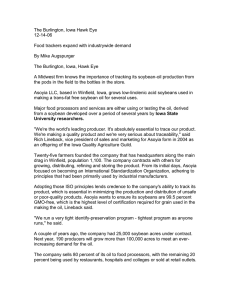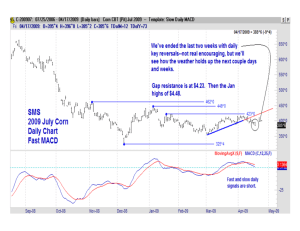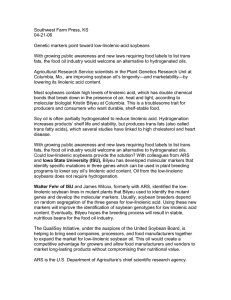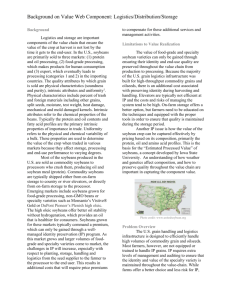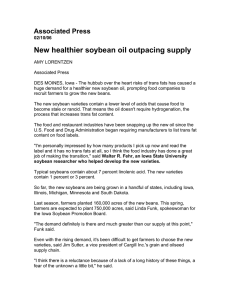Bismarck Farm and Ranch Guide, ND 03-03-07
advertisement
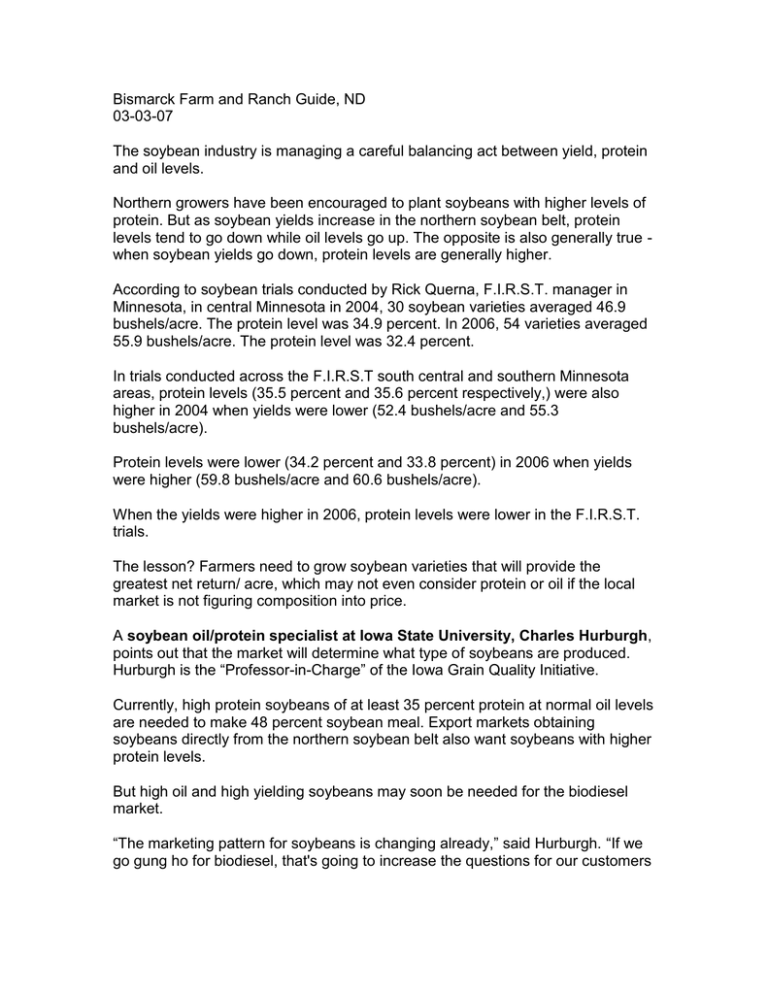
Bismarck Farm and Ranch Guide, ND 03-03-07 The soybean industry is managing a careful balancing act between yield, protein and oil levels. Northern growers have been encouraged to plant soybeans with higher levels of protein. But as soybean yields increase in the northern soybean belt, protein levels tend to go down while oil levels go up. The opposite is also generally true when soybean yields go down, protein levels are generally higher. According to soybean trials conducted by Rick Querna, F.I.R.S.T. manager in Minnesota, in central Minnesota in 2004, 30 soybean varieties averaged 46.9 bushels/acre. The protein level was 34.9 percent. In 2006, 54 varieties averaged 55.9 bushels/acre. The protein level was 32.4 percent. In trials conducted across the F.I.R.S.T south central and southern Minnesota areas, protein levels (35.5 percent and 35.6 percent respectively,) were also higher in 2004 when yields were lower (52.4 bushels/acre and 55.3 bushels/acre). Protein levels were lower (34.2 percent and 33.8 percent) in 2006 when yields were higher (59.8 bushels/acre and 60.6 bushels/acre). When the yields were higher in 2006, protein levels were lower in the F.I.R.S.T. trials. The lesson? Farmers need to grow soybean varieties that will provide the greatest net return/ acre, which may not even consider protein or oil if the local market is not figuring composition into price. A soybean oil/protein specialist at Iowa State University, Charles Hurburgh, points out that the market will determine what type of soybeans are produced. Hurburgh is the “Professor-in-Charge” of the Iowa Grain Quality Initiative. Currently, high protein soybeans of at least 35 percent protein at normal oil levels are needed to make 48 percent soybean meal. Export markets obtaining soybeans directly from the northern soybean belt also want soybeans with higher protein levels. But high oil and high yielding soybeans may soon be needed for the biodiesel market. “The marketing pattern for soybeans is changing already,” said Hurburgh. “If we go gung ho for biodiesel, that's going to increase the questions for our customers that need protein. What do we do for our long-term export customers? What do we do if we turn all of our soybeans into biofuels?” Determining yield, protein and oil The research is clear that Minnesota's and North Dakota's soybeans are about two percentage points lower in protein than soybeans in Arkansas - as well as soybeans raised in Brazil. Hurburgh sites a few of the reasons for the protein shortfall. - Shorter growing season. Hurburgh says that protein is more or less synthesized in the final portion of the plant growing cycle. “If you have a shorter growing season, then it tends to cut off the development of protein,” he said. “You end up with soybeans that have good oil content, but the protein isn't so high as compared to the rest of the country.” - Environment and day length also affect protein and oil levels. Warm temperatures at the time of flowering will generally favor oil production. Warm temperatures at the end of the growing season will favor protein production. A cold end to the growing season generally produces a low protein year. - Breeding programs that focus totally on yield will likely have lower rates of protein and higher rates of oil. “It is possible that through genetic developments, seed breeders and biotechnologies may be able to break some of those links,” said Hurburgh. Each year, environment plays a huge role on the ultimate protein and oil levels found in soybeans. To get around the environmental factor, the breeding companies plant one or two varieties that have proven acceptable levels of oil and protein every year. The criteria for the development of new varieties require the same or better protein and oil than the benchmark varieties. “That tends to keep the protein levels from falling,” said Hurburgh, indicating that 20 years of data at Iowa State University support the concept that soybean breeders have kept protein levels constant through this method. His concern is that good genetics are overlooked because of the protein/oil criteria. Only 25-30 percent of new varieties will meet protein/oil goals and offer above average yields. “You pass over genetics that could give you some substantial yield increases,” he said. “By narrowing your genetic base down, in the long run that probably reduces the rate by which yield can go up again.” Should we care about soybean protein? Hurburgh thinks that Minnesota and North Dakota's protein levels may be fine just they way they are now. His research suggests that while protein falls in northern soybeans, essential amino acids do not. “If you are an astute livestock feeder, you can use that information to save money with low-protein soybeans,” he said. “Part of the protein in soybeans includes the non-essential amino acids that can lead to over feeding nitrogen.” For the time being, soybean processors still need 35 percent protein soybeans to make 48 percent soybean meal. The 35 percent protein/19 percent oil is the target advocated by the United Soybean Board Select Yield and Quality Program - mainly in response to the needs of larger export customers. “I would raise the question of why are we really paying so much attention to protein in today's market dynamics? Especially with all the Distillers' grains, we have a surplus of protein,” said Hurburgh. With U.S. farmers planting 6-8 million acres to corn instead of soybeans this year, soybeans may become a valuable commodity. The world is going to need more soybeans to produce biodiesel in the very near future. Hurburgh thinks that although northern soybeans may be lower in protein, they still have very good feed value, and could work well for a domestic advantage. “It would seem that we could work some things internally to take advantage of that, and at the same time essentially maximize the oil yield because that's where we are going to want to meet our growing demand,” he said. “I think the market is going to be oil driven. We're going to be short of vegetable oil, and soybean oil makes the best biodiesel.” By having a soybean market that is more driven by oil than protein, breeders will have a better opportunity to breed more yield into new soybean varieties. Hurburgh added that emphasizing soybean yield and oil does not “win friends” in the export market. With exports drawing shiploads of soybean directly from North Dakota and Minnesota, Asia already has the challenge of blending soybeans to get higher protein levels. “There aren't any real magic answers,” he said. “We may have to ‘dedicate' somehow a number of southern and eastern soybean acres to the export market.” At the same time, with November soybean futures over $8/bushel in midFebruary, the market is rewarding producers for high soybean production. “We can afford to dramatically increase yield when soybeans are $9-$10, where we couldn't even think about it at $4/bushel,” said Hurburgh. “We may come right up against this protein problem and decide we'll feed the protein we have to our livestock. We'll balance it out as best we can, but we need soybean yield.” Minnesota Soybean Research & Promotion Chairman Rob Hanks says we should still be concerned with the quality of northern soybeans. “The Asian buyers of soybeans shipped out of the Pacific Northwest get frustrated with the low protein and I'm concerned they will look for alternatives,” Hanks said. Minnesota soybeans are already being discounted for quality through a wider basis - generally 9-10 cents less than what elevators pay for soybeans raised farther south. “The Department of Energy has funded sequencing the genome of the soybean. This should be completed in early 2008,” Hanks said. “This may have a significant impact on enhancing the desirability of all soybeans.”


